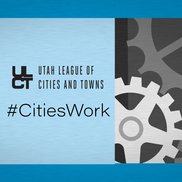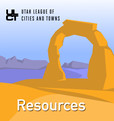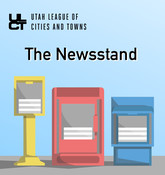|
The legislative session ended two weeks ago, but the past fortnight feels much, much longer. We have had two business weeks under the Governor’s recommendations to flatten the curve on COVID-19. Since that time, your correspondent and the ULCT staff has dedicated ourselves entirely to being your advocates and conduits of information about how your city and town is affected and can affect change. This week’s email will recap a huge week of COVID-19 related activity. You can track city specific resources on the ULCT website and overall data at coronavirus.utah.gov. You can also always send questions HERE and we are trying to answer them as quickly as possible.
It will explain the Governor's "Stay Home- Stay Safe" Directive (effective tonight), promote the “Utah Leads Together” plan for public health and economic recovery, recap the federal CARES Act, link to key resources on our website, identify next steps, and spotlight our podcast about COVID-19 related changes to the 2020 Census, .
Governor’s “Stay Safe, Stay Home” Directive: What Cities Need to Know
Today Governor Gary Herbert issued “The Governor’s Coronavirus Directive for Utah ‘Stay Safe, Stay Home’” (directive). This statewide guidance establishes minimum standards in the continued effort to minimize the health and economic impacts of the COVID-19 virus. The governor emphasized that the directive is a reinforcement of steps outlined in the Utah Leads Together plan and is driven by public health data, needs, and recommendations. The following is a summary highlighting what the directive means for municipalities. The directive is in place until 11:59 p.m. on April 13, 2020. All previous orders of the governor are still in place until they expire or are extended, including those not cited in the directive. Additionally, as a general rule, the local health department cannot be less restrictive than the state health department.
Individuals
Individuals are directed to stay and work at home as much as possible, self-quarantine if traveling or exposed to an individual with COVID-19 symptoms, engage in social distancing, and observe strict hygiene standards.
Governance
The directive reinforces minimum statewide standards that are intended to cover most jurisdictions within the state. A municipality should comply with the directive and make every effort to follow the standards set by the governor. If a municipality believes that local circumstances and concerns call for more stringent standards, the municipality should first consult with the local health department who in turn will consult with state authorities. If the state and local health departments consent to more stringent standards, the municipality may then impose stricter standards.
As circumstances continue to change, a municipality should communicate and work closely with its local health department.
Municipal authority
Although the directive establishes minimum statewide standards, a municipality may still exercise its inherent municipal authority, including decisions about municipal property and programs. For example, if a municipality owns a golf course and determines that it is appropriate to close the course, the municipality may close the municipal course without needing consent of the local health department or the State of Utah.
A municipality who believes local circumstances and concerns call for more stringent standards on private property, the municipality should first consult with the local health department. The local health department then consults with state authorities.
The directive states that children should not be allowed on public playground equipment; that individuals should not participate in activities at gyms, fitness centers, public places of amusement or activity, or public swimming pools; and individuals should not congregate at trailheads or in other outdoor spaces. A municipality should determine how to best comply with the directive if the municipality operates or has jurisdiction over any of the aforementioned facilities or locations.
Municipal employees and offices
A municipality should continue municipal business but under the standards for For-Profit and Nonprofit Organizations set forth in the directive. A municipality should facilitate teleworking (working from home) and institute social distancing as much as possible. A municipality should require an employee who reports or exhibits virus symptoms to return home immediately, implement staggered shifts when appropriate, and encourage other behaviors consistent with the directive and local health authority guidance. (See ULCT suggested best practices.)
The directive standards do not apply to law enforcement and first responders.
For more municipal resources on COVID-19, visit ULCT.org. Questions? Please contact Cameron Diehl cdiehl@ulct.org or Victoria Ashby vashby@ulct.org.
Utah Leads Together
On Tuesday afternoon, Governor Herbert announced the Utah Leads Together plan. You can read the one page summary HERE or view the full document HERE. The Governor announced the plan in a press conference and then he and the Lt. Governor outlined the plan to mayors, council members, and county commissioners during our weekly coordination call. You can see the video of the Lt. Governor’s Q&A HERE. Your correspondent provided analysis on the Tuesday evening email. The updated summary is below:
- Urgency: The Governor told the press and the Lt. Governor told local leaders that the Utah Leads Together plan is a strategy to flatten the curve, protect public health, stabilize the economy, and avoid a shelter-in-place mandate at this time. Speaker of the House Brad Wilson emphasized that the next week or so will be critical to implement the public health recommendations to flatten the curve. All state leaders emphasized that the plan is dynamic and will be reevaluated hourly as more data arrives.
- Testing, testing, testing. Everything is dependent on testing people and tracking the spread of the virus.
- No "one-size-fits-all”: The Governor expressed a willingness to look at different solutions for different regions and supported Summit County’s declaration of shelter-in-place on Wednesday evening.
- The "Utah" way: The Governor and Lt. Governor have emphasized that this is a collaborative and comprehensive approach, unlike what some are seeing in other states.
CARES Act
The United States Congress passed the CARES Act which provides about $2 trillion in fiscal stimulus for individuals, businesses of all shapes and sizes, and local governments. The CARES Act has a funding stream for state and local governments to seek reimbursement for direct COVID-19 costs. That’s the good news. The incomplete news is figuring out the amount of the pie, the reimbursement rules, and the process with the State of Utah and other local governments. You can see more resources from Sen. Romney--including our Q&A with him on Wednesday HERE and resources from Sen. Lee HERE.
Your correspondent was on a conference call with other state league directors and the National League of Cities this morning. Meanwhile, NLC has already initiated discussion with several Senators who have expressed a willingness to help on revenue replacement for local governments in a future bill. Those conversations are in the very early phases because the focus to date was the CARES Act and follow up.
Next steps
The last two weeks have been intense but we are always asking this key question: where do we go from here? Here’s what Team ULCT is doing now to help #citieswork:
- DIRECTIVE: ULCT needs to follow the directive as outlined above.
-
FISCAL IMPACT: We have assembled a group of city managers, finance directors, and other experts from cities and towns across Utah to understand the scope of the direct and indirect fiscal impact of COVID-19 on municipalities. The CARES Act provides some resources for local governments to reimburse direct costs but does not provide resources for the expected revenue impact from taxes, utility rates, and more. That group met today and will be nimble. Contact Wayne Bradshaw for more information at wbradshaw@ulct.org. Stay tuned for surveys and other data requests from us.
-
BEST PRACTICES: We have posted best practices on our website from our ULCT-UCMA survey on our website so that you can utilize at your City Hall to protect public health and continue to provide services.
-
COMMUNICATION WITH RESIDENTS: We are working on a template for you to use about how to communicate to your residents how you are implementing the Governor’s Utah Leads Together Plan at a local level.
-
HELPING BUSINESS: We are partnering with EDCUtah on a project to highlight how city leaders are helping businesses.
-
CENSUS: We released a podcast about how COVID-19 is impacting the census and highlighting what you as local leaders can do to ensure that your residents are counted this spring despite the crisis.
-
STATE ENGAGEMENT: ULCT staff is actively engaged in several statewide strategic groups:
- The subgroups include: i) state/local resources, ii) housing, iii) critical infrastructure/essential employees, iv) communication, v) child care for first responders
-
OVERALL ENGAGEMENT: We are coordinating with the National League of Cities about what we can learn from other states, with our federal delegation about the implementation of the CARES Act, and with state, business, and county leaders about potential orders and recommendations.
Our Board of Directors will meet on Monday at noon (see agenda here) to discuss the next steps.

Spotlight
In addition to all the news on the coronavirus, the count has begun for the US Census. In today's spotlight, your correspondent speaks with national and local census officials about things you as community leaders need to know about important dates, the benefits of an accurate count, and how to assure your residents are counted. Listen to today's #CitiesWork podcast here.
For more information click the tab below for census information from the National League of Cities or click here for state resources on the 2020 census.
|

Resources and Training
Due to the spread of COVID-19, our LUAU trainings are pending. We will pass along information about these no-cost trainings when they resume. It'll be an excellent resource for your community and will come direct from the USU Taylorsville site to a city or town near you.
|

The Newstand
|
|